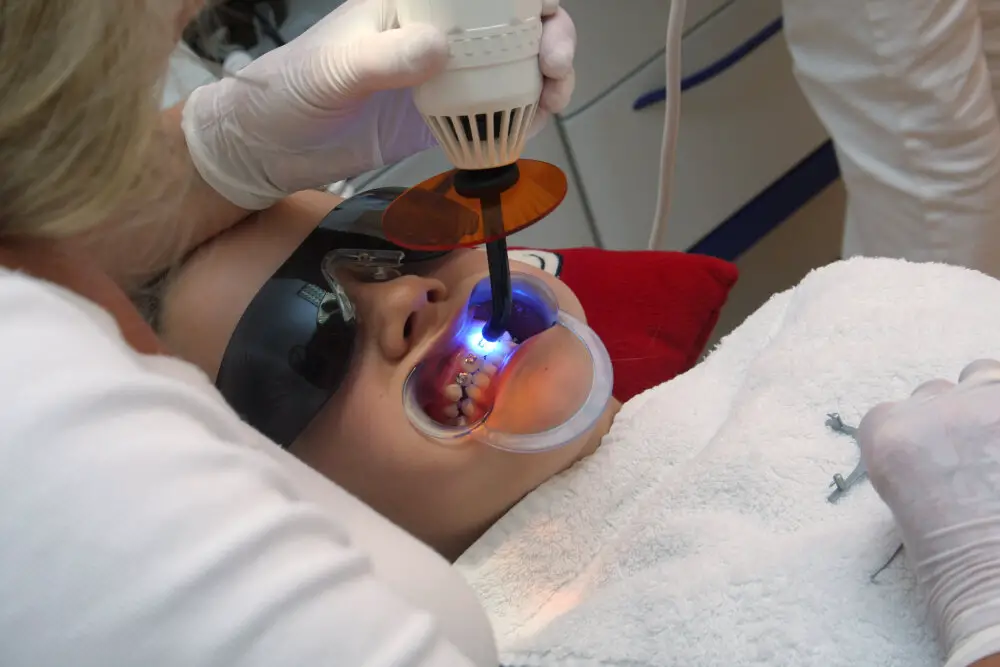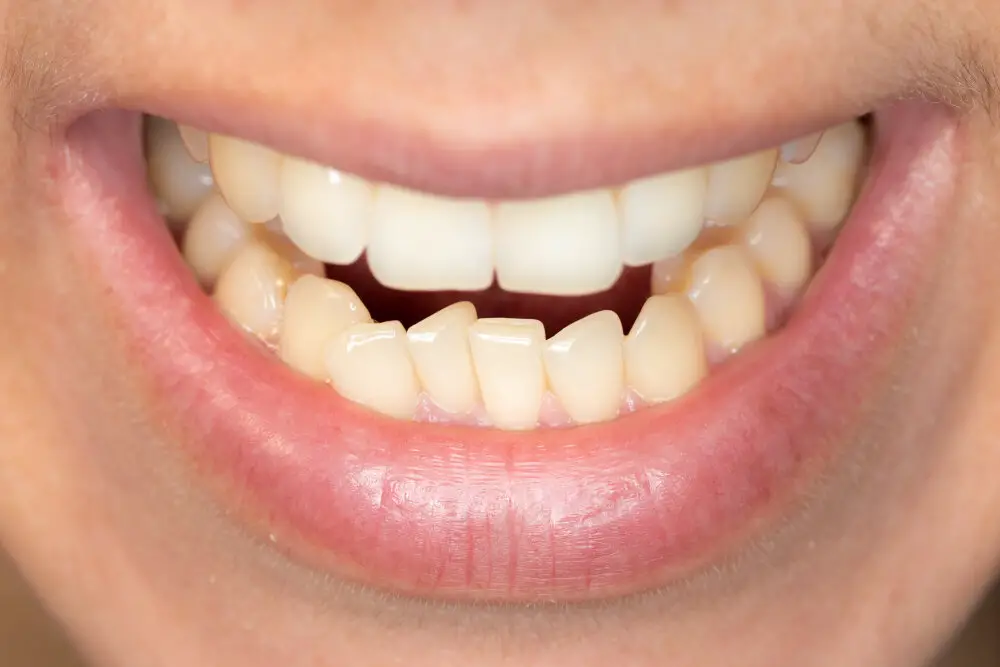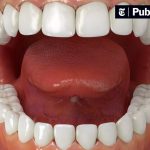Unveiling the Mystery: What Teeth Look Like Under Veneers

When it comes to enhancing the appearance of teeth, veneers have been a popular and effective solution for many. They are thin, custom-made shells that are placed over the natural teeth to improve their shape, size, and color. While veneers are known to provide a flawless smile, many people wonder what their teeth actually look like under these dental restorations. This curiosity has led to the unveiling of the mystery regarding the appearance of teeth under veneers. The process of getting veneers involves removing a small amount of the tooth enamel to make space for the veneer to fit on top of the tooth. This begs the question of what the teeth actually look like underneath the veneers. Are they damaged or discolored? Do they look natural or fake? These questions have sparked interest among dental professionals and patients alike, leading to a deeper understanding of the dental restoration process and the appearance of teeth under veneers. In this article, we will explore the mystery of what teeth look like under veneers and uncover the truth about this popular cosmetic dental treatment.
Dental veneers are thin, custom-made shells that are designed to cover the front surface of teeth to improve their appearance. They are typically made from porcelain or composite resin and are bonded to the tooth using a strong adhesive. Veneers can be used to address a variety of cosmetic concerns, such as chips, cracks, stains, and gaps between teeth. They can also be used to improve the size, shape, or length of teeth. Veneers are a popular cosmetic dentistry option because they are minimally invasive and can provide a dramatic improvement in the appearance of teeth. With proper care, veneers can last for many years.
The purpose of this article is to provide readers with an in-depth understanding of what teeth look like under veneers. Many people opt for veneers to enhance the appearance of their teeth, but they may not fully comprehend the impact these cosmetic procedures have on their natural teeth. This article aims to unveil the mystery by exploring the various types of veneers, how they are applied, and what lies beneath them. By shedding light on this topic, readers can make informed decisions regarding their dental health and understand the long-term implications of veneers. Overall, this article serves as an educational resource for those interested in cosmetic dentistry and the impact it has on their natural teeth.
What Are Dental Veneers?

Dental veneers are thin shells made of porcelain or composite resin that are placed on the front surface of the teeth to improve their appearance. They are custom-made to match the color, shape, and size of the patient’s teeth. Dental veneers are a popular cosmetic dentistry option to fix a range of dental issues such as chipped, discolored, or misaligned teeth. They are also used to restore teeth that have been worn down due to teeth grinding. The process of getting dental veneers involves two appointments. During the first appointment, the dentist will prepare the teeth by removing a small amount of enamel from the surface of the teeth to make room for the veneers. Then, the dentist will take impressions of the teeth, which will be used to create the custom-made veneers. The second appointment involves the placement of the veneers on the teeth. The dentist will first ensure that the veneers fit and look natural, then they will bond the veneers to the teeth using a special dental adhesive. With proper care, dental veneers can last for many years and provide patients with a beautiful, confident smile.
Dental veneers are thin, custom-made shells that are designed to cover the front surface of teeth to improve their appearance. They are typically made of porcelain or composite resin materials and are bonded to the front of teeth using a dental adhesive. Veneers can be used to enhance the shape, size, and color of teeth, as well as to cover up imperfections such as chips, cracks, or stains. They are a popular cosmetic dental treatment option for those who desire a brighter, more uniform smile. While veneers are a minimally invasive and relatively quick procedure, it is important to note that they are not suitable for everyone and should be discussed with a qualified dental professional.
Dental veneers are thin, custom-made shells that are placed on the front surface of the teeth to improve their appearance and durability. There are two types of dental veneers: porcelain and composite. Porcelain veneers are made of high-quality, durable porcelain material that is stain-resistant and can last up to 15 years with proper care. They are more expensive than composite veneers, but they offer superior durability and a natural-looking appearance. Composite veneers, on the other hand, are made of a resin material that is applied to the teeth in layers and then hardened with a special light. They are less expensive than porcelain veneers, but they are not as durable and may need to be replaced more frequently. Ultimately, the choice between porcelain and composite veneers depends on the patient’s individual needs and budget.
Dental veneers are thin, custom-made shells that cover the front surface of teeth to improve their appearance. They are commonly used to correct teeth that are discolored, chipped, or misaligned. Veneers can be made from different materials, including porcelain, composite resin, or ceramic. They are applied in a multi-step process that involves preparing the tooth, taking impressions, fabricating the veneer, and bonding it to the tooth. Veneers can provide a natural-looking and long-lasting solution to many cosmetic dental concerns. However, they require proper care and maintenance to ensure their longevity and avoid complications such as decay or damage to the underlying tooth structure.
Why Do People Get Dental Veneers?

Dental veneers are a popular cosmetic dental treatment that provides an effective solution for people who wish to improve the appearance of their teeth. Veneers are thin shells made from porcelain or composite resin that are bonded to the front surface of the teeth. They can be used to correct a wide range of dental problems, including chipped, cracked, or misshapen teeth, as well as discoloration, gaps between teeth, and minor misalignments. People who get dental veneers often do so because they want to enhance their smile and boost their self-confidence. Veneers can give them a brighter, more symmetrical, and more attractive smile, which can improve their overall appearance and make them feel better about themselves. Another reason why people get dental veneers is that they are a minimally invasive and relatively quick solution for improving the appearance of their teeth. Unlike other cosmetic dental treatments, such as braces or dental implants, veneers require minimal preparation and can be completed in just a few visits to the dentist. The procedure involves removing a small amount of enamel from the front surface of the teeth, taking impressions of the teeth, and then bonding the veneers to the teeth using a special adhesive. The result is a natural-looking and long-lasting solution that can improve the appearance of the teeth without the need for extensive dental work. Overall, dental veneers are a popular and effective cosmetic dental treatment that can help people to achieve the smile they have always wanted.
Dental veneers are a popular cosmetic treatment that can help improve the appearance of your teeth. One of the main reasons people choose to get veneers is to cover up imperfections such as chips, cracks, or stains that cannot be removed with regular teeth whitening treatments. Veneers are also used to correct minor alignment issues and to close gaps between teeth. In addition, veneers can help improve the size and shape of teeth, creating a more symmetrical and aesthetically pleasing smile. Overall, dental veneers are an effective solution for those looking to enhance their smile and boost their confidence.
Dental veneers are thin, custom-made shells that cover the front surface of teeth, and they offer a variety of benefits. First and foremost, they can improve the appearance of teeth that are discolored, misshapen, or chipped. Veneers can also help to close gaps between teeth and improve the overall alignment of the teeth. Additionally, veneers are a relatively non-invasive cosmetic procedure, as they require minimal tooth preparation and can often be placed in just a few visits. With proper care, veneers can last for many years and provide patients with a confident, natural-looking smile. Overall, dental veneers are an excellent option for those looking to enhance the appearance of their teeth and achieve a more beautiful, radiant smile.
Before getting dental veneers, there are several important considerations to keep in mind. First and foremost, it is crucial to have a thorough consultation with a qualified dentist to determine if veneers are the right choice for your specific dental needs. It is also important to carefully consider the cost of the procedure, as veneers can be quite expensive. Additionally, it is important to understand that veneers are a permanent solution, as a small amount of tooth enamel must be removed to apply them. Patients should also be aware that veneers may not be suitable for those with severe dental issues, and may require additional dental work prior to the procedure. Finally, it is important to carefully research and choose a qualified and experienced dentist who can ensure the best possible results.
What Do Teeth Look Like Under Veneers?

Veneers are thin, custom-made shells that are placed on the front surface of teeth to improve their appearance. They are made of porcelain or composite resin and are designed to match the natural color of your teeth. Veneers can help to correct a variety of dental issues, including stains, chips, gaps, and uneven teeth. However, many people wonder what their teeth actually look like under veneers. The truth is that veneers are designed to mimic the natural appearance of teeth, so they look very similar to real teeth. Underneath the veneers, your natural teeth will still have the same basic structure as before. They will have a root that extends into the jawbone and a crown that is visible above the gumline. The main difference is that the veneers will cover the front surface of the teeth, hiding any imperfections that may have been present. Veneers are also designed to be very durable and long-lasting, so they can provide a natural-looking solution for many years to come. Overall, veneers are an excellent option for anyone who wants to improve the appearance of their teeth while maintaining a natural look and feel. In conclusion, veneers are an effective way to improve the appearance of your teeth without sacrificing their natural look. They are designed to match the color and shape of your natural teeth, so they blend in seamlessly. Underneath the veneers, your teeth will still have the same basic structure as before, but any imperfections will be hidden from view. If you are considering veneers, it is important to work with a qualified dental professional who can help you achieve the best possible results. With the right care and maintenance, veneers can provide a long-lasting solution that can help you feel confident and happy with your smile.
Veneers are thin, custom-made shells used to cover the front surface of teeth to improve their appearance. They are typically made of porcelain or composite resin, and can be used to cover a variety of dental imperfections, such as chips, cracks, gaps, and discoloration. Veneers can also be used to correct the size, shape, and alignment of teeth, giving patients the opportunity to achieve a more symmetrical and aesthetically pleasing smile. Despite their many benefits, veneers are not suitable for everyone, and patients should consult with a qualified dentist to determine whether they are a good candidate for this type of cosmetic dentistry.
Natural teeth and veneers have their own set of advantages and disadvantages. Natural teeth are unique to each individual and, with proper care, can last a lifetime. However, they are susceptible to decay, discoloration, and damage. Veneers, on the other hand, are made of porcelain or composite resin and can be custom-made to match the color, shape, and size of a person’s natural teeth. They are durable and can last up to 10-15 years with proper care. However, they are not as strong as natural teeth and can chip or crack under pressure. Additionally, veneers require some removal of the tooth enamel, which can cause sensitivity and discomfort. Ultimately, the decision between natural teeth and veneers comes down to personal preference and individual circumstances.
Before and after veneers can produce incredible transformations in a person’s smile. A set of veneers can correct an array of dental issues such as discolored or misshapen teeth, gaps, and chips. The before and after photos often show a marked difference in the shape, size, and color of the teeth. For example, a person with yellowed, crooked teeth may have a Hollywood-worthy smile after getting veneers. The veneers can create a uniform appearance, close gaps, and cover any chips or cracks. The results are often stunning, and the confidence boost that comes with a new smile can be life-changing. However, it’s important to remember that veneers are not a one-size-fits-all solution and should only be considered after consulting with a qualified dental professional.
Caring for Teeth with Veneers

If you have veneers, it’s essential to take good care of them to ensure their longevity. While veneers are durable and stain-resistant, they still require regular maintenance to keep them looking their best. To care for your veneers, you should brush your teeth twice a day with a non-abrasive toothpaste and floss daily. It’s also important to avoid biting down on hard objects like ice and using your teeth as tools, which can cause your veneers to chip or break. Additionally, you should visit your dentist regularly for check-ups and cleanings. During these appointments, your dentist can evaluate the condition of your veneers and address any issues before they become more significant problems. If you notice any changes in the appearance or feel of your veneers, such as sensitivity or a loose veneer, you should contact your dentist right away to schedule an appointment. With proper care, your veneers can last for many years and continue to enhance your smile.
Maintenance of veneers is essential for their longevity and to ensure that they continue to look natural and beautiful. It is important to maintain good oral hygiene by brushing and flossing regularly to prevent any build-up of plaque and tartar. Avoiding hard and sticky foods can also help prevent damage to the veneers. Regular dental check-ups are necessary to monitor the health of the veneers and to identify any issues early on. Additionally, using a mouthguard when playing sports or grinding your teeth at night can protect the veneers from damage. By following these simple guidelines, you can maintain your veneers and enjoy a healthy and beautiful smile for many years to come.
Maintaining oral hygiene is crucial to ensure the longevity of veneers. Brushing twice a day and flossing regularly can help prevent plaque buildup and staining around the edges of the veneers. Using a soft-bristled toothbrush and non-abrasive toothpaste can prevent scratching the surface of the veneers. It is also recommended to avoid hard and crunchy foods, as well as habits such as nail-biting and chewing on pens, which can damage the veneers. Regular dental check-ups and professional cleanings are also essential to keep the veneers and the underlying teeth healthy. By following these oral hygiene practices, individuals can enjoy a beautiful and healthy smile with their veneers.
While veneers are an excellent cosmetic solution for a variety of dental problems, they do come with potential risks and complications that patients should be aware of. For starters, the procedure itself can be quite invasive, as a thin layer of enamel is removed from the teeth in order to accommodate the veneers. This can lead to tooth sensitivity and even damage to the teeth if the procedure is not done properly. Additionally, veneers can become dislodged or damaged over time, requiring repair or replacement. Patients who grind their teeth may be at a higher risk for these issues, as the constant pressure can wear down the veneers more quickly. Finally, while veneers can improve the appearance of teeth, they do not necessarily address underlying oral health issues, such as gum disease or tooth decay. As such, it is important for patients to maintain good dental hygiene practices in order to prevent these problems from developing.
In summary, the article delves into the intriguing world of dental veneers and uncovers the mystery of what teeth look like under them. The author explains that veneers are thin, customized shells made of porcelain or composite resin that are attached to the front surface of the teeth to improve their appearance. While veneers are known for their ability to transform the look of teeth, the article reveals that they are not a one-size-fits-all solution and that the success of veneers depends on various factors, such as the thickness of the veneers and the color of the underlying teeth. The article also emphasizes the importance of proper dental care and maintenance to ensure the longevity and effectiveness of veneers. Overall, the article provides valuable insights into the world of cosmetic dentistry and highlights the importance of informed decision-making when it comes to dental procedures.
In conclusion, understanding what teeth look like under veneers is essential for anyone considering this cosmetic dental procedure. While veneers can provide a beautiful, uniform appearance to your smile, it is important to remember that they are not a one-size-fits-all solution. Before undergoing the procedure, it is recommended that you consult with a qualified and experienced cosmetic dentist to ensure that veneers are the right choice for you. It is also important to maintain good oral hygiene habits to keep your natural teeth healthy and ensure the longevity of your veneers. With proper care and attention, veneers can be a great way to achieve a brighter, more confident smile.
If you’re considering getting veneers, it’s important to seek professional advice from a qualified dentist. They can assess your dental health and determine if veneers are a suitable option for you. Furthermore, they can discuss the different types of veneers available and the benefits and drawbacks of each. Seeking professional advice can also help manage your expectations and ensure that you understand the process and potential outcomes. Remember, veneers are a major investment in your dental health and appearance, so it’s important to make an informed decision. Don’t hesitate to schedule a consultation with a dentist to discuss your options and get the best possible results from your veneers.
Conclusion

In conclusion, the mystery of what teeth look like under veneers has been unveiled. It is now known that veneers can provide a beautiful and natural-looking smile, but it is also important to understand the potential drawbacks and limitations of this cosmetic dental procedure. While veneers can improve the appearance of teeth, they are not a substitute for good oral hygiene and regular dental checkups. It is crucial to consult with a qualified dentist and make an informed decision before undergoing any dental treatment. With the right approach, veneers can be a valuable tool in achieving a confident, healthy, and radiant smile.





